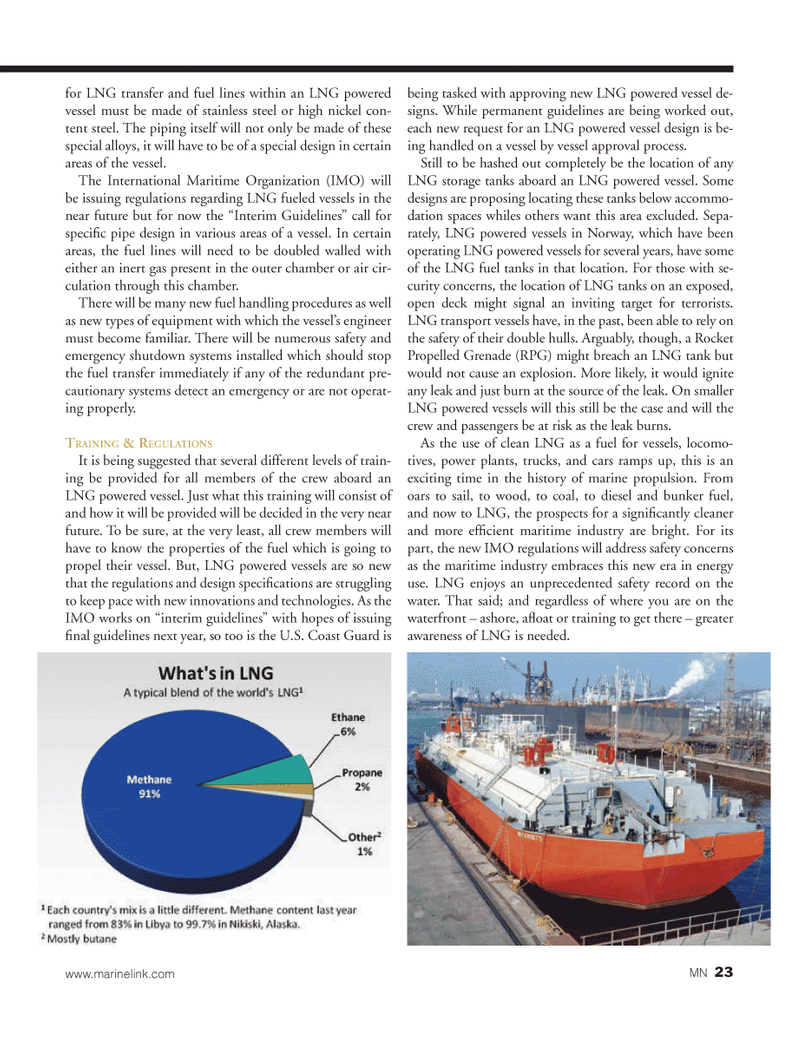
Page 23: of Marine News Magazine (January 2014)
Tug Boat Technology
Read this page in Pdf, Flash or Html5 edition of January 2014 Marine News Magazine
for LNG transfer and fuel lines within an LNG powered vessel must be made of stainless steel or high nickel con- tent steel. The piping itself will not only be made of these special alloys, it will have to be of a special design in certain areas of the vessel.
The International Maritime Organization (IMO) will be issuing regulations regarding LNG fueled vessels in the near future but for now the “Interim Guidelines” call for specifi c pipe design in various areas of a vessel. In certain areas, the fuel lines will need to be doubled walled with either an inert gas present in the outer chamber or air cir- culation through this chamber.
There will be many new fuel handling procedures as well as new types of equipment with which the vessel’s engineer must become familiar. There will be numerous safety and emergency shutdown systems installed which should stop the fuel transfer immediately if any of the redundant pre- cautionary systems detect an emergency or are not operat- ing properly.
TRAINING & REGULATIONS
It is being suggested that several different levels of train- ing be provided for all members of the crew aboard an
LNG powered vessel. Just what this training will consist of and how it will be provided will be decided in the very near future. To be sure, at the very least, all crew members will have to know the properties of the fuel which is going to propel their vessel. But, LNG powered vessels are so new that the regulations and design specifi cations are struggling to keep pace with new innovations and technologies. As the
IMO works on “interim guidelines” with hopes of issuing fi nal guidelines next year, so too is the U.S. Coast Guard is being tasked with approving new LNG powered vessel de- signs. While permanent guidelines are being worked out, each new request for an LNG powered vessel design is be- ing handled on a vessel by vessel approval process.
Still to be hashed out completely be the location of any
LNG storage tanks aboard an LNG powered vessel. Some designs are proposing locating these tanks below accommo- dation spaces whiles others want this area excluded. Sepa- rately, LNG powered vessels in Norway, which have been operating LNG powered vessels for several years, have some of the LNG fuel tanks in that location. For those with se- curity concerns, the location of LNG tanks on an exposed, open deck might signal an inviting target for terrorists.
LNG transport vessels have, in the past, been able to rely on the safety of their double hulls. Arguably, though, a Rocket
Propelled Grenade (RPG) might breach an LNG tank but would not cause an explosion. More likely, it would ignite any leak and just burn at the source of the leak. On smaller
LNG powered vessels will this still be the case and will the crew and passengers be at risk as the leak burns.
As the use of clean LNG as a fuel for vessels, locomo- tives, power plants, trucks, and cars ramps up, this is an exciting time in the history of marine propulsion. From oars to sail, to wood, to coal, to diesel and bunker fuel, and now to LNG, the prospects for a signifi cantly cleaner and more effi cient maritime industry are bright. For its part, the new IMO regulations will address safety concerns as the maritime industry embraces this new era in energy use. LNG enjoys an unprecedented safety record on the water. That said; and regardless of where you are on the waterfront – ashore, afl oat or training to get there – greater awareness of LNG is needed. www.marinelink.com MN 23
MN JAN14 Layout 18-31.indd 23 12/20/2013 10:06:06 AM

 22
22

 24
24
